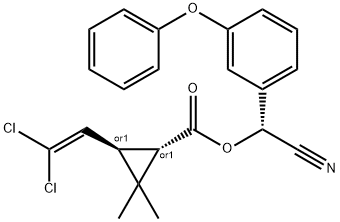2-(4-((3-Chloro-5-(trifluoromethyl)-2-pyridinyl)oxy)phenoxy)-propanoic acid methyl ester
Synonym(s):(R)-2-{4-[3-Chloro-5-(trifluoromethyl)-2-pyridyloxy]phenoxy}propanoic acid methyl ester
- CAS NO.:72619-32-0
- Empirical Formula: C16H13ClF3NO4
- Molecular Weight: 375.73
- MDL number: MFCD04112762
- EINECS: 406-250-0
- SAFETY DATA SHEET (SDS)
- Update Date: 2024-07-23 18:28:04

What is 2-(4-((3-Chloro-5-(trifluoromethyl)-2-pyridinyl)oxy)phenoxy)-propanoic acid methyl ester?
The Uses of 2-(4-((3-Chloro-5-(trifluoromethyl)-2-pyridinyl)oxy)phenoxy)-propanoic acid methyl ester
Haloxyfop-R-methyl-d3 is a labeled analogue of (R)-Haloxyfop Methyl Ester (H104020), which is a herbicide. It is used in the study of reduced rates of the acetyl-co enzyme A carboxylase (ACCase)-inhibiting herbicide.
Definition
ChEBI: Haloxyfop-P-methyl is a methyl 2-(4-{[3-chloro-5-(trifluoromethyl)pyridin-2-yl]oxy}phenoxy)propanoate that has R configuration. It is a proherbicide (by hydrolysis of the methyl ester) for the herbicide haloxyfop-P, the most active enantiomer of the racemic herbicide haloxyfop. It has a role as a proherbicide, an EC 6.4.1.2 (acetyl-CoA carboxylase) inhibitor and an agrochemical. It is functionally related to a haloxyfop-P. It is an enantiomer of a (S)-haloxyfop-methyl.
Properties of 2-(4-((3-Chloro-5-(trifluoromethyl)-2-pyridinyl)oxy)phenoxy)-propanoic acid methyl ester
| Boiling point: | 390.8±42.0 °C(Predicted) |
| Density | 0.968 |
| vapor pressure | 0Pa at 20℃ |
| Flash point: | 2 °C |
| storage temp. | 2-8°C |
| solubility | Chloroform (Slightly), Ethyl Acetate (Slightly) |
| pka | -1.52±0.32(Predicted) |
| form | neat |
| Water Solubility | 8.74 mg/L at 20 ºC |
| Stability: | Hygroscopic |
| CAS DataBase Reference | 72619-32-0(CAS DataBase Reference) |
Safety information for 2-(4-((3-Chloro-5-(trifluoromethyl)-2-pyridinyl)oxy)phenoxy)-propanoic acid methyl ester
| Signal word | Warning |
| Pictogram(s) |
 Exclamation Mark Irritant GHS07  Environment GHS09 |
| GHS Hazard Statements |
H302:Acute toxicity,oral H410:Hazardous to the aquatic environment, long-term hazard |
| Precautionary Statement Codes |
P264:Wash hands thoroughly after handling. P264:Wash skin thouroughly after handling. P270:Do not eat, drink or smoke when using this product. P273:Avoid release to the environment. P391:Collect spillage. Hazardous to the aquatic environment P301+P312:IF SWALLOWED: call a POISON CENTER or doctor/physician IF you feel unwell. P501:Dispose of contents/container to..… |
Computed Descriptors for 2-(4-((3-Chloro-5-(trifluoromethyl)-2-pyridinyl)oxy)phenoxy)-propanoic acid methyl ester
New Products
(S)-3-Aminobutanenitrile hydrochloride 4-Methylphenylacetic acid N-Boc-D-alaninol N-BOC-D/L-ALANINOL Tert-butyl bis(2-chloroethyl)carbamate 3-Morpholino-1-(4-nitrophenyl)-5,6-dihydropyridin- 2(1H)-one Furan-2,5-Dicarboxylic Acid Tropic acid 1-Bromo-3,5-Di-Tert-Butylbenzene S-2-CHLORO PROPIONIC ACID ETHYL ISOCYANOACETATE 2-Bromo-1,3-Bis(Dimethylamino)Trimethinium Hexafluorophosphate 4-IODO BENZOIC ACID 3-NITRO-2-METHYL ANILINE 1-(2,4-DICHLOROPHENYL) ETHANAMINE (2-Hydroxyphenyl)acetonitrile 4-Bromopyrazole 2-(Cyanocyclohexyl)acetic acid 4-methoxy-3,5-dinitropyridine 1-(4-(aminomethyl)benzyl)urea hydrochloride 2-aminopropyl benzoate hydrochloride diethyl 2-(2-((tertbutoxycarbonyl)amino) ethyl)malonate tert-butyl 4- (ureidomethyl)benzylcarbamate Ethyl-2-chloro((4-methoxyphenyl)hydrazono)acetateRelated products of tetrahydrofuran








You may like
-
 Haloxyfop-P-methyl CAS 72619-32-0View Details
Haloxyfop-P-methyl CAS 72619-32-0View Details
72619-32-0 -
 2033-24-1 98%View Details
2033-24-1 98%View Details
2033-24-1 -
 1975-50-4 98%View Details
1975-50-4 98%View Details
1975-50-4 -
 2-HYDROXY BENZYL ALCOHOL 98%View Details
2-HYDROXY BENZYL ALCOHOL 98%View Details
90-01-7 -
 2-Chloro-1,3-Bis(Dimethylamino)Trimethinium Hexafluorophosphate 221615-75-4 98%View Details
2-Chloro-1,3-Bis(Dimethylamino)Trimethinium Hexafluorophosphate 221615-75-4 98%View Details
221615-75-4 -
 61397-56-6 CIS BROMO BENZOATE 98%View Details
61397-56-6 CIS BROMO BENZOATE 98%View Details
61397-56-6 -
 14714-50-2 (2-Hydroxyphenyl)acetonitrile 98+View Details
14714-50-2 (2-Hydroxyphenyl)acetonitrile 98+View Details
14714-50-2 -
 118753-70-1 98+View Details
118753-70-1 98+View Details
118753-70-1
Statement: All products displayed on this website are only used for non medical purposes such as industrial applications or scientific research, and cannot be used for clinical diagnosis or treatment of humans or animals. They are not medicinal or edible.